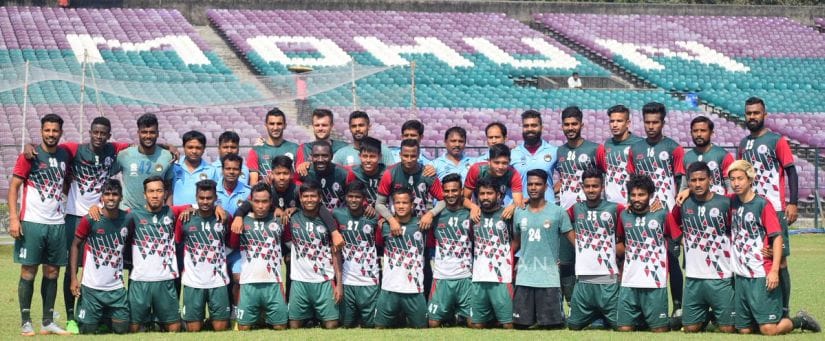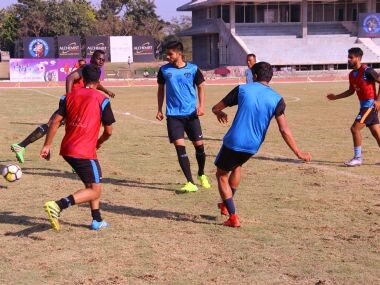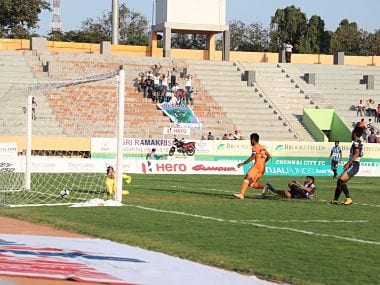At the end of a topsy-turvy season, Minerva Punjab FC pulled off a shock triumph. It’s only the second club from Punjab, and North India, to win the national league — 22 years since JCT won the inaugural National Football League (NFL) in 1996.
Newly-formed Gokulam Kerala FC enthralled spectators in Kozhikode, while Imphal-based NEROCA FC, the first top-division club from Manipur, finished runners up in a stunning first season. Chennai City FC, now plying in Coimbatore, survived relegation by the skin of their teeth and the Arrows project returned after four years in the wilderness.
Meanwhile, Mohun Bagan and East Bengal struggled to cope with the drain of Indian talent to the ISL. In an unprecedented season having two concurrent leagues, the 2017/18 I-League played second fiddle to the Indian Super League (ISL) — and this, greater than anything else, defined the dynamics of the season.
Underdogs breathe life into dying league
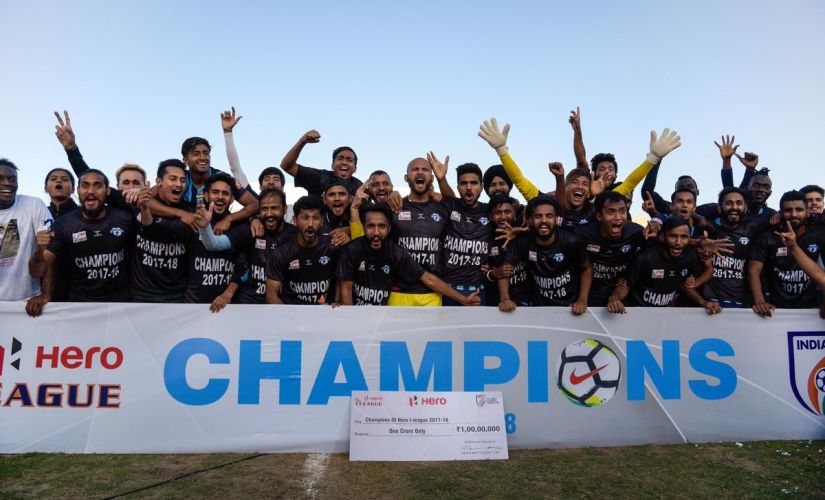
Minerva Punjab surprised everyone with their improvement in the 2017-18 I-League. Image Courtesy: Twitter/@Minerva_AFC
With less than two weeks to assemble a squad and prepare for their debut season in 2017, Minerva had finished second from bottom. Instability, then, had been the order of the day: the Punjab club used an astonishing 36 different players including 15 Under-22 players. It was easily the league’s highest, almost 10 players more than the average.
Fast forward to 2018 and ‘stability’ is the key word: 27 players used but 11 of whom made more than 12 starts. Foreign players Eric Dano, Chencho Gyeltshen (the best forward this season) and Kassim Aidara started all 18 matches. William Opoku started in 17. Indian players, such as Gagandeep Bali who played in multiple positions, complemented the solid foreign spine. That being said, it is hard to pick an Indian player who you’d think would be a national team regular in this title-winning squad — which tells you about the strength of Minerva’s foreign brigade and the collective effort of the squad. Minerva weren’t the best team to watch but they were the hardest team to play against.
If not for Minerva, second-placed NEROCA FC would’ve hogged all of the headlines. Coach Raikhan’s men finished with the league’s best defensive record, conceding only 13 times in 18 games—which is quite a feat for a debutant team. But the Manipuri club found goals hard to come by, scoring only 21 — the least among the top five. As per official attendance figures, an average of 24,494 spectators turned out in Imphal to watch NEROCA play. And they, along with fans in Coimbatore and Kozikhode, breathed some life into a dying league.
Curious fixture scheduling
57 (63%) out of the 90 I-League matches were played on weekdays. Only 15 games kicked off at 8 PM, which is considered television prime time. None of the weekend matches were at night. Mohun Bagan did not play even a single game (home or away) at night whereas East Bengal hosted only two night matches. Meanwhile, two night fixtures were played in Shillong, where weather and the availability of transportation is not suited for such times. A mere three clubs (NEROCA FC, Gokulam Kerala FC and East Bengal) hosted more games on a weekend than they did on weekdays. Minerva hosted just one game, the opening one against Bagan, on a weekend. It was clear that the I-League made way for the glitzy ISL this season — and this was done in a deliberate manner.
Day and timings aside, the home-away scheduling was oddly skewed — which was partially due to Chennai City’s home Coimbatore venue not being ready in time for the start. During the course of this season, Bagan had eight home games in a row, whereas Minerva had to contend with seven straight away fixtures. NEROCA, too, hosted six in a row, while Aizawl had five consecutive away days and Churchill had five straight at home. All of this affects a club’s entire season — could Bagan have won the league if its injury crisis hadn’t coincided with a bizarre run of home matches which usually yields close to maximum points? Further more, there was an incredible 18-day gap between NEROCA’s penultimate and final game.
Is it really too much to ask for a simple, sensible and intelligent fixture list for a change?
A stepping stone for Indian coaches
By the end of the I-League season, all clubs except the Indian Arrows had Indian coaches at the helm. It was a refreshing sight, especially when you consider how Indians have to play a secondary role in the ISL. Minerva’s Manipuri head coach Khogen Singh became the first coach from the north-east to win the national league. NEROCA FC’s Gift Raikhan pulled off a sensational debut campaign. Gokulam Kerala FC’s Bino George got his house in order midway through the campaign and masterminded victories over both the Kolkata teams and Minerva in a span of nine days. Since 2014, the I-League had been the stepping stone for players to play in the more lucrative ISL. It can become a similar platform for coaches as well — just look at Kerala Blasters assistant coach Thangboi Singto.
Kolkata’s big two
For two seasons in a row, Bagan and East Bengal have let relative minnows, with a fraction of their resources, lift the league title. Without Bengaluru FC to challenge their might, with the league’s top Indians in their squad and also more foreigners allowed in the playing XI than ever before, this was a season tailor-made for either of the two to be champions. It’s a damning indictment of the Kolkata duo’s way of functioning that they didn’t. Both clubs are in need of an overhaul, a more professional approach both on and off the pitch. Their legacies will remain forever but Indian football 2.0 is here and now, and both these clubs are in danger of being left behind.
Refereeing under the scanner
Match officials came under heavy scrutiny this season due to some major mistakes which have been played up even more due to enhanced television and digital coverage. If they got away with errors in the previous years, they didn’t this time around — with videos of decisions floating around on social media as well.
As Hindustan Times pointed out, the parallel leagues have been tough on referees with them rushing across India to officiate in both ISL and I-League games due to a limited set of qualified referees in India. Goutam Kar, AIFF’s director of referees, told ESPN.in that India has around 6500 referees compared to Japan’s 375,000. There’s a need for a much bigger pool of these in India and more chances for them to perform at lower levels and hone their skills, which is tough considering the dearth of organised football at state level.
Importing foreign referees is a stop-gap solution but it does not help the Indian ecosystem in the long run. AIFF has a review system in place to analyse refereeing decisions. Develop that further to improve Indian referees gradually rather than import officials from abroad.
A foreign musical chairs
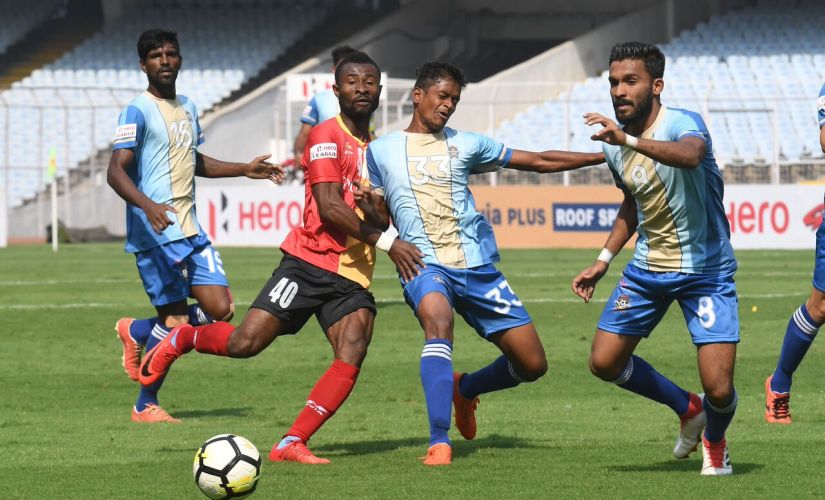
East Bengal's Ansumana Kromah (LC) joined the club from Mohun Bagan in January. Image Courtesy: I-League
Recruitment of foreigners reached absurd levels this season. It was summed up by forward Willis Plaza, who had parted ways with East Bengal in January, being recruited by Churchill Brothers for only the final game in a desperate attempt to stave off relegation (which they could not). Bazie Armand, another East Bengal reject, was signed by Minerva with the sole purpose of getting a psychological edge in a big title race fixture versus the Kolkata club (which Minerva lost).
Ansumana Kromah was let go by Mohun Bagan for poor performances and was signed by rivals East Bengal a few weeks later. In the meantime, Kromah found time to play in local pay-as-you-play matches. NEROCA coach Raikhan treated Kyrgyzstani midfielder Israilov Akhlidin like coaches treat an Under-22 player: substituted him awkwardly early in games (31st, 34th and 25th minutes on three occasions) before replacing him in February.
Gokulam Kerala FC used 10 foreign players across the season (clubs were allowed only six in the squad and five on the field at any given time), which was second only to relegated Churchill’s 12. Gokulam can be excused for trying to find their feet in their debut season but what is Churchill’s excuse? Even the Kolkata teams look like high achievers compared to the Goan club’s abysmal planning and execution.
In 2017, the average number of foreigners used by clubs was just over four (4.3) per club with no club exceeding five. This season, with the league allowing an extra foreign player, it rose to nearly eight (7.9) per club (not counting the Indian Arrows). It reflects the reality of a division which could not hold onto its best Indian players and where clubs were aware that foreigners would make the decisive impact.
Every foreigner signed, though, and every contract terminated is spillage. These are funds diverted away from investing back into the development of the sport. To this end, this I-League campaign did more harm than good to football in India.
Akarsh Sharma is a business guy who spends much of his free time writing and researching on sport. His writing is collated on akarshsharma.com and he tweets @Akarsh_Official
Published Date: Mar 12, 2018 20:03 PM | Updated Date: Mar 12, 2018 20:03 PM

